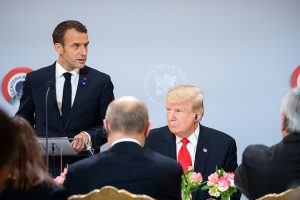by Greg Thielmann
The Trump administration’s 120-day “stay of execution” for the Iran nuclear deal has temporarily sidelined arguments over the absence of constraints on ballistic missiles as one of the agreement’s principal flaws. But if this “flaw” is not quickly put in proper perspective, the issue could help undermine one of the most important non-proliferation achievements of our era.
Iran’s current ballistic missile development program is neither illegitimate nor disproportionate given that country’s size and security situation. It is high time for opponents and supporters of the Iran nuclear deal (the Joint Comprehensive Plan of Action, or JCPOA) to address this subject in a more balanced way.
President Donald Trump characterized his January 12 waiver of nuclear-related sanctions on Iran as a “last chance” for the JCPOA parties to negotiate an agreement “to fix the terrible flaws of the Iran nuclear deal,” including the lack of constraints on ballistic missile development. He called for Congress to state explicitly that “long-range missiles and nuclear weapons programs are inseparable, and that Iran’s development and testing of missiles should be subject to severe sanctions.” Trump’s statement also called for a supplemental agreement with key allies that would, inter alia, “impose new multilateral sanctions if Iran develops or tests long-range missiles.”
At a time when Trump has chosen to vilify Iran’s government and people, and seeks to sabotage multilateral arms control agreements, it is not surprising that the president has labeled Iran’s entire ballistic missile program an unacceptable security threat to the United States. However, the frequency and ease with which Trump makes this charge should not obscure a reality that is far more nuanced than the prevailing narrative.
Debunking the Claims
True, Iran has the largest arsenal of short- and medium-range ballistic missiles in the region. But these missiles do not have the range of those possessed by its regional adversaries, Israel and Saudi Arabia. Nor are they armed with nuclear warheads like those of Israel and Pakistan.
Critics both foreign and domestic point to the size of Iran’s military expenditures. But Iran’s per capita military expenditures are significantly less than those of its immediate neighbors—and of Israel, which poses an existential threat. Iran’s air force is not only conspicuously inferior to Israel’s, but it is qualitatively inferior to the hostile air forces of Iran’s Persian Gulf neighbors.
As the ongoing crisis over North Korea’s nuclear and missile program dramatically illustrates, it is long-range, nuclear-armed missiles that pose the most acute threat to the United States. But despite longstanding and repeated warnings from the U.S. intelligence community that Iran was likely to have globe-spanning ICBMs by 2015, Iran enters 2018 with no operational missiles with ranges over 2,000 kilometers and (in stark contrast to North Korea) has explicitly stated it has no military need to extend that range. Moreover, as a signatory to the Nuclear Non-Proliferation Treaty, Iran has not only permanently foresworn developing nuclear warheads for its missiles and submitted to more than a decade of unprecedented international monitoring of its compliance with the JCPOA, it has also concentrated its technological efforts on improving missile accuracy rather than range—exactly the opposite of what one would expect from a nation seeking to develop and deploy nuclear weapons.
During the last decade, both President George W. Bush and President Barack Obama took steps to defend Europe and the United States against the potential emergence of a nuclear missile threat from Iran. But in crafting the European Phased Adaptive Approach (EPAA) in 2009, Obama devised a Europe-based missile defense program better suited to the evolution of the actual Iranian threat than that chosen by President Bush. Four years later, in response to growing evidence that the Iranian missile threat to Europe and the United States was falling short of earlier projections, Obama appropriately cancelled the fourth stage of scheduled EPAA deployments, which were designed to provide an additional layer of protection to the United States beyond that provided by the strategic missile defenses already deployed in Alaska and California.
The implementation of the 2015 JCPOA effectively blocked Iran’s potential pathways to developing nuclear warheads. Moreover, Iran’s flight-test program has subsequently shown no clear movement toward development of ICBMs that could reach the United States—or even of IRBMs (with ranges of 3,000-5,500 kilometers), which could reach the heart of Europe. Unfortunately, Obama and NATO did not adapt their plans further to the downward evolving threat by canceling or postponing the SM3-IIA (Aegis Ashore) missile deployments to Poland, which seems to validate Moscow’s longstanding charge that this system had always been oriented toward Russia rather than the Middle East.
Addressing the Real Problems
The preceding discussion should not be understood as a denial that Iranian ballistic missiles conflict with international nonproliferation objectives or with the interests of the United States and its friends and allies in the region. Nor does it constitute an argument against raising the costs of Iran’s missile programs by imposing sanctions on individuals and entities that facilitate them. In a report released last week, a UN panel concluded that Iran was in noncompliance with UNSC Resolution 2216 for failing to prevent the Houthi rebels in Yemen from obtaining Iranian missiles.
Yet, post-World-War II history provides numerous cautionary tales of what can happen when threats are misunderstood or exaggerated—either out of self-delusion or deliberate distortion. The 2003 Iraq “weapons of mass destruction” fiasco looms large in this regard. Washington’s mischaracterization of the Iraq threat then to justify the U.S./U.K. invasion should provide a clear warning about exaggerating the Iran threat 15 years later.
If the Trump administration genuinely wants to press for missile limits to strengthen the JCPOA rather than sabotage it, future negotiations will have to offer a formula for providing mutual advantages rather than merely a venue for delivering unilateral ultimatums. Examples could include a long-range missile test ban in the Middle East (which would also constrain Iran’s adversaries, Saudi Arabia and Israel) as well as conditional cooperation in Iran’s science-based space activities. Such an approach could yield arms-control dividends to the world without constraining Iran’s core security requirements and hobbling legitimate economic development.
From Washington’s perspective, Iran’s qualitative enhancement of its non-nuclear medium-range missile force is undesirable, but such an outcome does not constitute a game-changer in the political dynamics of the region. On the other hand, losing the JCPOA in a vain attempt to crush Iran’s missile program would represent a major setback to global non-proliferation goals. The United States should therefore take care not to throw the baby out with the bathwater.
Greg Thielmann, a board member of the Arms Control Association, is a former office director for Strategic, Proliferation, and Military Affairs in the State Department’s intelligence bureau (INR), and a former senior staffer on the Senate Intelligence Committee. Photo: Iran’s Khorramshahr missile (Wikimedia Commons).






Iran’s military spending is 2.6% of GDP compared to 13-15% by the Saudi, Oman, UAE etc. and then consider that their GDP is quite high too, and you get the real difference in spending. Iran instead spends its money on improving living standards which is why Iranians today live 22 years longer than before the revolution and their Human Development Index is higher than Turkey now
Cyrus, where is source of your statistics about Iranians living 22 years longer now than before the revolution?
Tony see Iran’s Human Development Index from 1980 to 2013 — google “HDI iran Iranprimer” for example
“Between 1980 and 2012, Iran’s life expectancy at birth increased by 22.1 years, mean years of schooling increased by 5.7 years, and expected years of schooling increased by 5.7 years. The gross national income per capita also increased by about 48 percent between 1980 and 2012.”
Note that Iran out-performed all countries but for China in this time period of 1980-2013, making Iran into a “Highly Developed Nation”: Iran’s HDI improved 67% compared to Chinas’ 72%. Brazil, India, S Korea, Turkey all failed to do as well as Iran (40-58%) Note also that prior to the revolution Iran’s HDI rate was low, and hardly rising at all.
One wonders if the American public will ever wake up to the fact that our foreign policy, or better, our lack of a cogent and progressive policy in the Middle East that furthers our national interest while creating an environment conducive to future peace, is a slave to right wing reactionaries in Israel and the U.S. They believe like Dick Cheney, you create your own reality with your guns and missiles. It is a failed policy of a small minority who should have no further voice in the matter because their advice has proven so wrong for so long. The Neo-Con gang, whose influence culminated in Secretary Powell’s unforgettable performance at the U.N., and our total loss of international credibility in 2003, should have no voice or influence in our Foreign Policy. They were caught outright “cooking the books”, exposed and discredited. That they are still affecting anything is testimony to the power of their patrons check books. Sheldon Adelson has more control of our Foreign Policy over there than our own State Department.